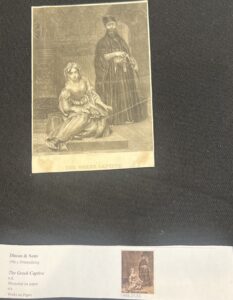“Make me in marble after I am dead;”
This is the opening line to Eugene Lee-Hamilton’s poem “At Rest”. In this poem, Lee-Hamilton writes of his wishes for a memorial statue to be made of him. He asks that he be made “as they knew me” (line 4).
In another one of his poems, “To the So-Called Venus of Milo”, Lee-Hamilton once again refers to marble statues, specifically Venus de Milo. She is beautiful, regardless of her physical differences. The Venus de Milo is a Hellenistic style statue depicting a half-covered Aphrodite made in about 150 BC. It was recovered in pieces and reconstructed, but its arms were never found (“Venus de Milo”). Ancient Greek statues like this one were idealized and perfected, any ‘imperfections’ would be removed and replaced in favor of constructing an ideal, unattainable body. Hellenistic statues are mainly dynamic and express movement in their posing. In “At Rest”, Lee-Hamilton expresses his desire to become a marble figure, one of the famed classics. However, unlike the classic statues he references, his memorial will not be ‘perfected.’
Here, he has the opportunity to imagine his statue however he wants, yet he chooses to keep his disability. The statue is to be “recumbent,” just as he was (line 2). He does not want or envision his perfect self with a “fixed” body. Instead, he wants to be made into art. He wants to be admired and respected; most importantly, he wants to be noticed.
By turning himself into a piece of artwork to be observed, Lee-Hamilton takes on a role similar to nude women in art. Through the Victorian period, as interest in beauty grew so did the popularity of the nude. Women’s bodies were something of fascination, an unparalleled kind of beauty to be portrayed by skilled artists. But this admiration of the female figure did not come without constraints. The viewers of these artworks feared the “dangerous sexual powers” of women (Lee). To control this fear, and to control women the “women are rendered decorative, depersonalized…women are reduced to an aesthetic arrangement of sexual parts, for male fantasies” (Lee). Stripped of their identity, the women portrayed in art are not people; they are no more than a collection of carefully arranged color and line (Lee).
To allow the nude body to be shown publicly, and to evade the onslaught of the Victorians, artists had to distance the figure from reality. This was often accomplished by relating the artwork to myth or by abstracting elements to remove the body from reality. This created distance allowed the spectators to look without consequence. This can be seen in the Venus de Milo. The statue depicts Aphrodite: a goddess, not a woman. She is allowed to be nude because she is not real. This makes a dissonance that allows the viewers to enjoy the sensuousness of the body while denying any lust. Additionally, she is not fully uncovered, the lower half of her body is draped with cloth. In the most accepted theory of its original form, her right arm is believed to be reaching for the draping (Kousser, 239). This pose justifies her nudity while still maintaining sensuality. Even with the prudish nature of the period, Venus de Milo was regarded in the 19th century as “the embodiment of concepts such as Tradition and Taste” (N.).
This distance is applied by Lee-Hamilton towards his marble body in “At Rest.” However, this distance is not from nudity or sex, but from his disability. With the use of a marble statue Lee-Hamilton’s disability is removed from anything real. Onlookers can admire it without having to face reality. The statue is lifeless and feels no pain:
Save that the motionless and marble head
Will never ache with hope forever vain;
And down the marble limbs the waves of pain
Will never race, but all be peace instead. (line 5-8)
There are no consequences of Lee-Hamilton’s disability on the statue, so effectively it is not disabled. Viewers are able to gaze without having to confront the real-life hardships of disability. It is no longer something ‘ugly’ or uncomfortable. As with the female nude, Lee-Hamilton’s disability is now something to be admired.
And this admiration is welcomed. Lee-Hamilton in statue form is depicted sleeping, literally “At Rest.” This is a common pose for memorial statues, but it also invites a voyeuristic gaze. Being “safely asleep” welcomes spectators and provides further comfort (Lee). It allows viewers to look without confrontation; they don’t need to think about their role in the fetishization of the subject. Lee-Hamilton wants his body to be enticing, he wants people to look.
With his desire to be made a marble statue, Lee-Hamilton indicates a desire for attention and appreciation. He becomes a subject of voyeurism and he loses respect as a result. Like the nude woman, Lee-Hamilton becomes “dismembered [from his] body and [his] identity” (Lee). But he is willing to make this sacrifice. Lee-Hamilton allows, and perhaps even participates in, his own emasculation. In exchange, however, he regains agency. “The victims of this voyeurism still retain a certain amount [of] power over the viewer, who is enthralled with fascination” (Lee). The viewers are enticed by him, with his disability. He will not be excluded for being other, his differences will be the subject of admiration. Perhaps the reality of disability is too much for the Victorians, but Lee-Hamilton can receive their captivation.
Works Cited
Kousser, Rachel. “Creating the Past: The Vénus de Milo and the Hellenistic Reception of Classical Greece.” American Journal of Archaeology, vol. 109, no. 2, 2005, pp. 227–50. JSTOR, http://www.jstor.org/stable/40024510. Accessed 21 Apr. 2025.
Lee-Hamilton, Eugene. “At Rest.” Sonnets of the Wingless Hours, 1894, pp. 21.
N., A. A. “Venus de Milo.” The Classical Tradition, edited by Anthony Grafton et al., 1st ed., Harvard University Press, 2010. Credo Reference, https://search.credoreference.com/articles/Qm9va0FydGljbGU6MTIzMzM5NQ==?aid=104013.
“Venus de Milo.” Encyclopædia Britannica Online, Encyclopædia Britannica Inc, 2020.


